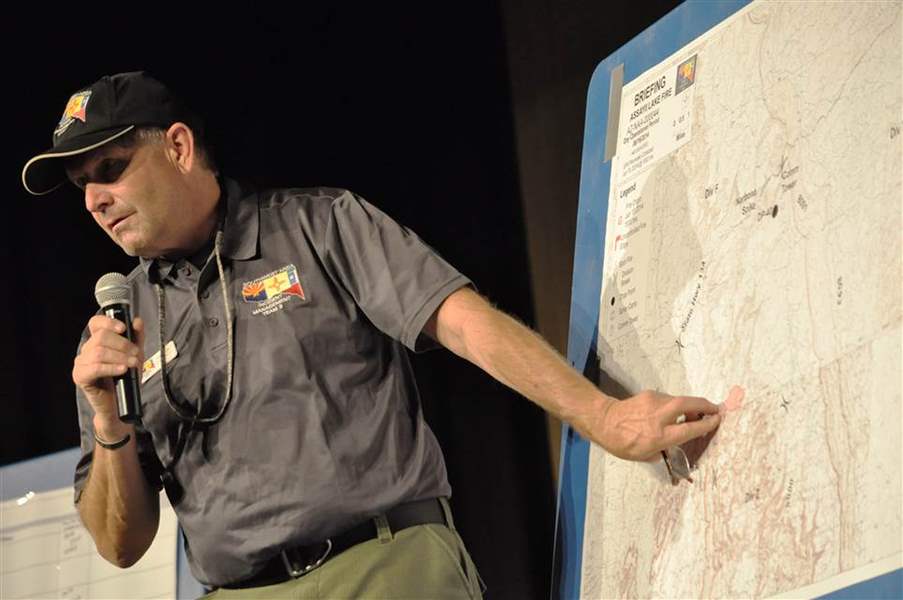
Navajo Nation wildfire threatens homes, livestock
6/17/2014
Operations Section Chief Darrell Willis with Southwest Area Incident Management Team 3 discusses the Asaayi Lake Fire during a briefing on Monday, June 16, 2014, in Window Rock, Ariz. Residents of two Native American communities near the New Mexico-Arizona border were forced to leave their homes Monday, June 16, 2014, as strong winds fanned the flames of a wildfire burning in the Chuska Mountains. The blaze ballooned to more than 17 square miles, forcing Navajo Nation police to issue an evacuation order for parts of Naschitti and nearby Sheep Springs. (AP Photo/Navajo Times, Ravonelle Yazzie)
ASSOCIATED PRESS
ALBUQUERQUE, N.M. — A fast-moving wildfire near the Arizona-New Mexico border grew today as it approached two communities and threatened traditional grazing lands on the Navajo Nation, where sheep are a staple of life, their wool is prized for its use in rugs, and mutton is on the menu of restaurants throughout the region.
The Assayii Lake Fire ballooned to more than 19 square miles in less than two days while making its way across winter and summer grazing lands in the Chuska Mountains.
The flames destroyed at least four structures and threatened about 50 homes near the rural communities of Naschitti and Sheep Springs, fire officials said.
Parts of the communities were evacuated Monday afternoon, and authorities were urging desperate Navajo families to refrain from going into the mountains to search for their sheep and other livestock due to the fire’s erratic behavior.
“They haven’t contained any of it yet, and they’re just letting it burn right now because the winds are so high, and that presents a problem,” said Leo Watchman, head of the Navajo Nation’s Department of Agriculture. “How far out do you evacuate homes and livestock pens? We’re not out of the danger yet.”
The tribal agency has been busy rounding up trailers to move livestock from the area. But Watchman said it was too early to say what might have happened to the sheep and cattle that were on the mountain when the fire broke out.
Agriculture and livestock have been key in the evolution of Navajo society and economy. Tribal members have grazed sheep in the area for centuries, and livestock ownership is considered a symbol of resourcefulness and prosperity.
Authorities did sweeps of sheep camps in the hills and evacuated some people Sunday and Monday. The fire has since burned through those areas, consuming dry pinon, juniper and brush.
Close to 600 firefighters and other personnel have been assigned to the blaze, along with dozens of engines, helicopters and planes. They were bracing for gusts of up to 50 mph today.
Fire officials said the weather has hampered efforts to directly attack the flames. Crews were scouting for places along the western and eastern flanks where they could begin building fire line.
The Assayii Lake Fire was one of several blazes making problems for western states.
In California, diminishing winds have helped firefighters surround 75 percent of a blaze burning near Lake Isabella in the southern Sierra Nevada. Residents were told late Monday they could return to some 1,000 mountain homes.
The blaze destroyed three houses, damaged another and forced hundreds to flee their homes. At least two of the burned houses appeared to be abandoned, the U.S. Forest Service said in a statement.
One other home was damaged by the fire, which charred more than 4 square miles of trees and brush in and around Sequoia National Forest. It also threatened power lines and communications facilities.
Firefighters were looking to build lines all the way around the blaze, and helicopter water drops and expected calm winds could help.
In northern Arizona, a 12-acre wildfire that broke out in Oak Creek Canyon was 25 percent contained. The fire was just north of a blaze that charred 31 square miles last month in the scenic canyon between Sedona and Flagstaff.